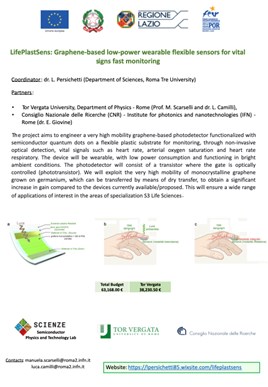The project LifePlastSens aims to engineer a very high mobility graphene-based photodetector functionalized with semiconductor quantum dots on a flexible plastic substrate for monitoring, through non-invasive optical detection, vital signals such as heart rate, arterial oxygen saturation and heart rate respiratory. The device will be wearable, with low power consumption and functioning in bright ambient conditions. The photodetector will consist of a transistor where the gate is optically controlled (phototransistor). We will exploit the very high mobility of monocrystalline graphene grown on germanium, which can be transferred by means of dry transfer, to obtain a significant increase in gain compared to the devices currently available/proposed. This will ensure a wide range of applications of interest in the areas of specialization S3 Life Sciences.
The project was funded through the projects of the Lazio Region "Research Groups 2020". In fact, the Lazio Region grants contributions to a non-repayable fund on the costs incurred by the Research and Dissemination of Knowledge Bodies (OdR) for the realization of CSR projects of potential interest to the companies of Lazio. To support the initiative, 20 million euros have been allocated from the POR FESR Lazio 2014 - 2020 (Action 1.2.1). To participate, the Projects must fall into one of the areas of specialization (AdS) of the Regional Smart Specialization Strategy (S3): Aerospace, Life Sciences, Cultural Heritage and Technologies of Culture, Agrifood, Digital Creative Industries, Green Economy and Security.
The partners who analyze the development of the LifePlastSens project are Roma Tre University (Department of Sciences), OdR leader, Roma "Tor Vergata" University (Department of Fi) and the National Council of (CNR) with the Institute of Photonics and Nanotechnologies (IFN).
For the Physics Department of the University of Rome "Tor Vergata" the reports are Prof. Manuela Scarselli and Dr. Luca Camilli. For more information on the project visit the LifePlastSens website.
![]()
